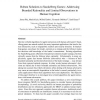303 search results - page 29 / 61 » Interfaces as Games, Programs as Strategies |
AI
2010
Springer
13 years 5 months ago
2010
Springer
How do we build algorithms for agent interactions with human adversaries? Stackelberg games are natural models for many important applications that involve human interaction, such...
FUNGAMES
2010
13 years 9 months ago
2010
Recent work in neuroscience suggests that there is a common coding in the brain between perception, imagination and execution of movement. Further, this common coding is considere...
FOSSACS
2003
Springer
14 years 1 months ago
2003
Springer
Genericity is the idea that the same program can work at many different data types. Longo, Milstead and Soloviev proposed to capture the inability of generic programs to probe th...
CHI
2009
ACM
14 years 9 months ago
2009
ACM
Interaction for desktop games is mostly limited to keyboard and mouse input. We are investigating the benefits of adding body-based interaction to complement keyboard and mouse in...
ACG
2006
Springer
14 years 2 months ago
2006
Springer
First, this paper introduces a new family of k-in-a-row games, Connect(m, n, k, p, q). In Connect(m, n, k, p, q), two players alternately place p stones on an m × n board in each ...


